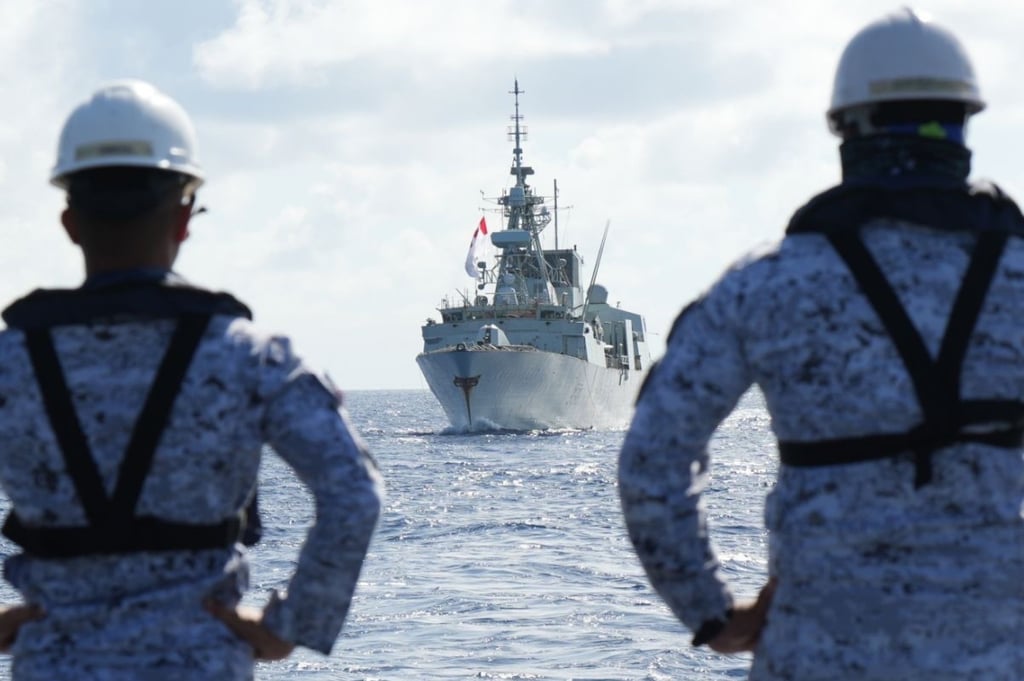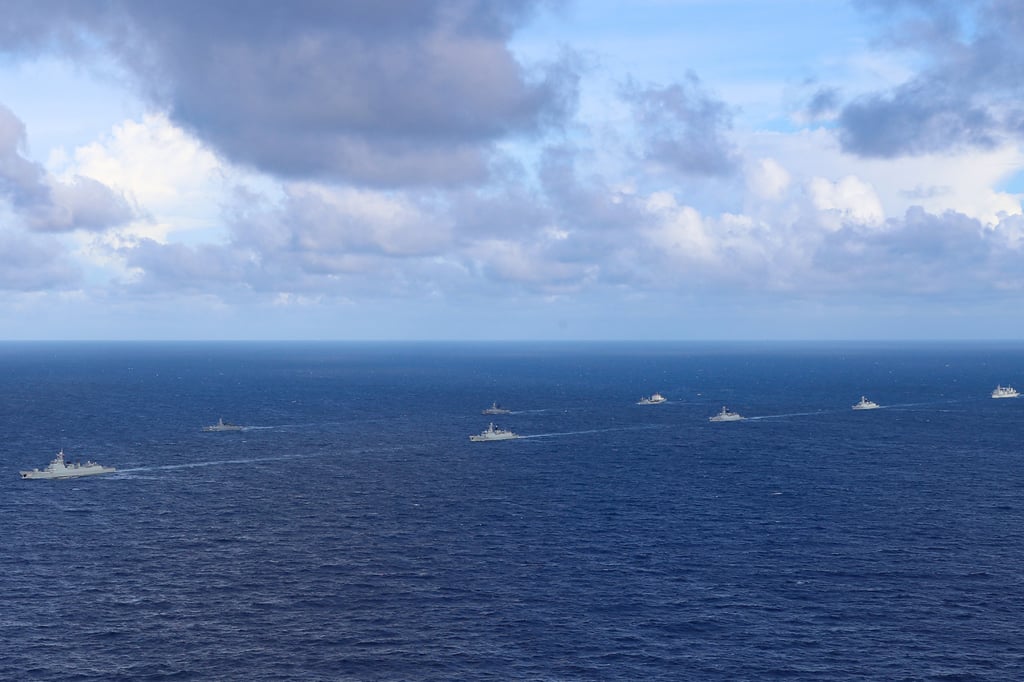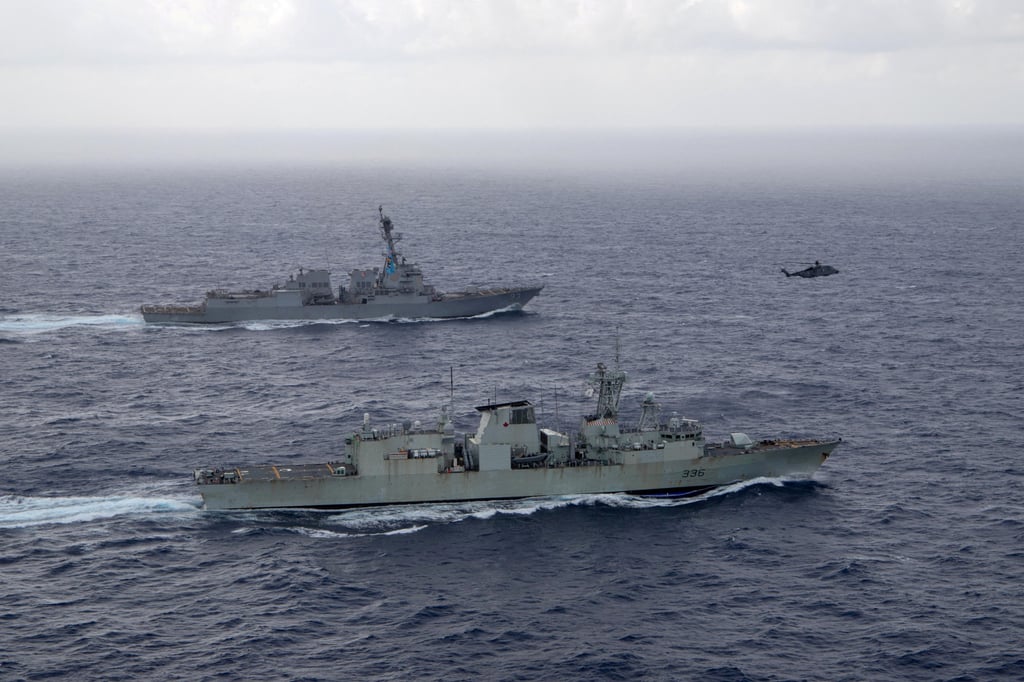
Canada’s Minister of National Defence Bill Blair (left) speaks to Australian Defence Minister Richard Marles in Vancouver on August 8. Photo: The Canadian Press via AP
Canada’s ‘absurd’ South China Sea play: challenging Beijing or undermining Asean?
- Canada’s symbolic vow to maintain order alongside Australia poses a threat to Asean centrality, analysts say

Maria Siow
Published: 3:30pm, 17 Aug 2024
Canada is wading into the contested waters of the South China Sea, joining forces with Australia to ramp up military and defence industry cooperation. The two countries, expressing alarm at China’s assertive claims in the vital waterway, are looking to counter Beijing’s growing influence in the region.
Speaking after talks with his Australian counterpart in Vancouver on August 8, Canadian Defence Minister Bill Blair accused China of trying to reshape the international system to advance its own interests, and said security in the Indo-Pacific was being challenged “in a number of significant and difficult ways”. Blair vowed that his nation would work more closely with Australia to maintain order in the region.
Greater involvement of outside powers in the South China Sea could serve as a counterweight against China’s assertiveness. But some observers caution that Canada’s interest may be “merely symbolic”, pointing to its lack of significant regional defence resources. Analysts say such moves could also prevent Southeast Asian nations from speaking with “one voice” – making it easier for Beijing to deal with a divided response.
The stakes are high. About US$5.5 trillion in global trade passes through the South China Sea’s strategic sea lanes each year, including a large portion of Canada’s commercial interests, according to Stephen Nagy, a professor of politics and international studies at Tokyo’s International Christian University.
Canada is also concerned about the potential impact on its semiconductor supply chains, which are deeply linked to Taiwan – where about 90 per cent of the world’s most advanced chips are manufactured.
Nagy said Canada was positioning itself as a champion of the “rules-based international order” in the face of China’s assertive posturing. In recent months, tensions in the South China Sea have boiled over, with Philippine and Chinese vessels clashing directly as Chinese personnel have deployed water cannons, boarded Philippine ships armed with axes and machetes, and destroyed equipment to disrupt Manila’s resupply missions to a contested shoal.

Philippine sailors watch Canada’s HMCS Montreal frigate during maritime drills with the US and Australia in the South China Sea on August 7. Photo: Philippine Armed Forces/Handout via EPA-EFE
‘Might-is-right approach’
Canada wants to counter what it sees as China’s “Machiavellian might-is-right approach to foreign affairs” in the region, according to Nagy. But its involvement could also put the centrality of the Association of Southeast Asian Nations (Asean) under threat.“Southeast Asian countries are trying to bring in extra-regional partners to balance the size of China,” Nagy said, with the goal of preventing US-China tensions from spiralling in a way that negatively affects the region.
After all, the Asean charter demands that the bloc remain the primary driver of external partnerships, rather than the dictates of great power rivalry.
Yet Canada’s entry into the South China Sea may make it harder for Asean to achieve a unified stance. Analysts say a divided bloc ultimately benefits China, as it can more easily pursue its preferred mode of bilateral negotiations rather than dealing with Asean as a whole.
Azmi Hassan, Malaysian foreign policy analystWith Canada joining, it is more difficult for Asean consensus to be achieved
Notably, Canada has already stepped up its engagement, providing the Philippines with access to its cutting-edge “dark vessel detection system” – satellite-powered technology designed to track even the stealthiest of illegal fishing boats. Nagy suggested that Ottawa may soon expand this cooperation to other Southeast Asian countries as well.
However, Malaysian foreign policy analyst Azmi Hassan said the presence of non-Asean actors made it difficult for the bloc to “achieve one voice” on the South China Sea dispute.
“With Canada joining, it is more difficult for Asean consensus to be achieved and this in a way benefits Beijing since a divided Asean will make it easier for China to pursue its bilateral mode of discussion,” said Azmi, a fellow at Malaysia’s National Council of Professors.
The problem, he explained, is that Asean is fundamentally split – some nations align with the US, others with China, while a third group “seem to care less since they are not directly involved in the dispute”.

Chinese and Russian vessels pictured during a joint exercise in the South China Sea in July. Photo: Xinhua
Azmi questioned whether the South China Sea was truly the best theatre for Canada to flex its military muscle. “If safeguarding international order is the main reason, then bolstering Canada’s presence in the Arctic region makes more sense,” he said, pointing to Russia and China’s growing polar footprint.
Indeed, a recent US defence report highlighted the threat of deepening Sino-Russian cooperation in the Arctic, with Moscow reopening and modernising abandoned bases and airfields from the Soviet era, while China has poured money into polar exploration with a view to building a “Polar Silk Road”.
Aspiration/capability mismatch
Canada fundamentally lacks the capabilities to take on a more muscular role in the South China Sea, according to Jeffrey Reeves, a security expert and senior fellow at the Institute for Peace and Diplomacy, a North American think tank.The Canadian navy is thought to have just three warships in the entire Asia-Pacific theatre – “such an inconsequential force as to be largely meaningless”, according to Reeves, who called the idea that Ottawa could influence the balance of power in the region “absurd”.
Despite its continued pledges of support to Ukraine, Canada continues to fall short of Nato’s minimum defence spending targets. This year, Ottawa is expected to allocate just 1.37 per cent of its gross domestic product to defence – well short of the transatlantic security alliance’s 2 per cent benchmark.

A Royal Canadian Navy frigate (front) sails alongside a US Navy guided-missile destroyer in the South China Sea last year. Photo: US Navy/Handout via Reuters
This shortfall has not gone unnoticed. Last month, Nato Secretary General Jens Stoltenberg called on Canada to increase its military spending and present a concrete plan to do so, in order to “show authoritarian regimes that Western allies are aligned”.
Yet even as it lags on defence spending, Canada has committed an additional C$500 million (US$362 million) in military aid to Ukraine this year. This comes on top of the projected C$4 billion (US$2.9 billion) in arms and munitions Canada has already pledged and delivered to Kyiv.
In Reeves’ view, Canada’s involvement in the South China Sea is “entirely symbolic” – aimed more at showing “its Western allies and partners that it backs their strategic aims, in however limited a fashion”.
“In this respect, Canada is part of the US ‘coalition of the willing’ in the Indo-Pacific,” he said.
“For Washington, Canada’s participation provides it with a measure of legitimacy. With Canada riding along, the US can say it is acting as part of a consortium of states rather than unilaterally keeping the peace.”

